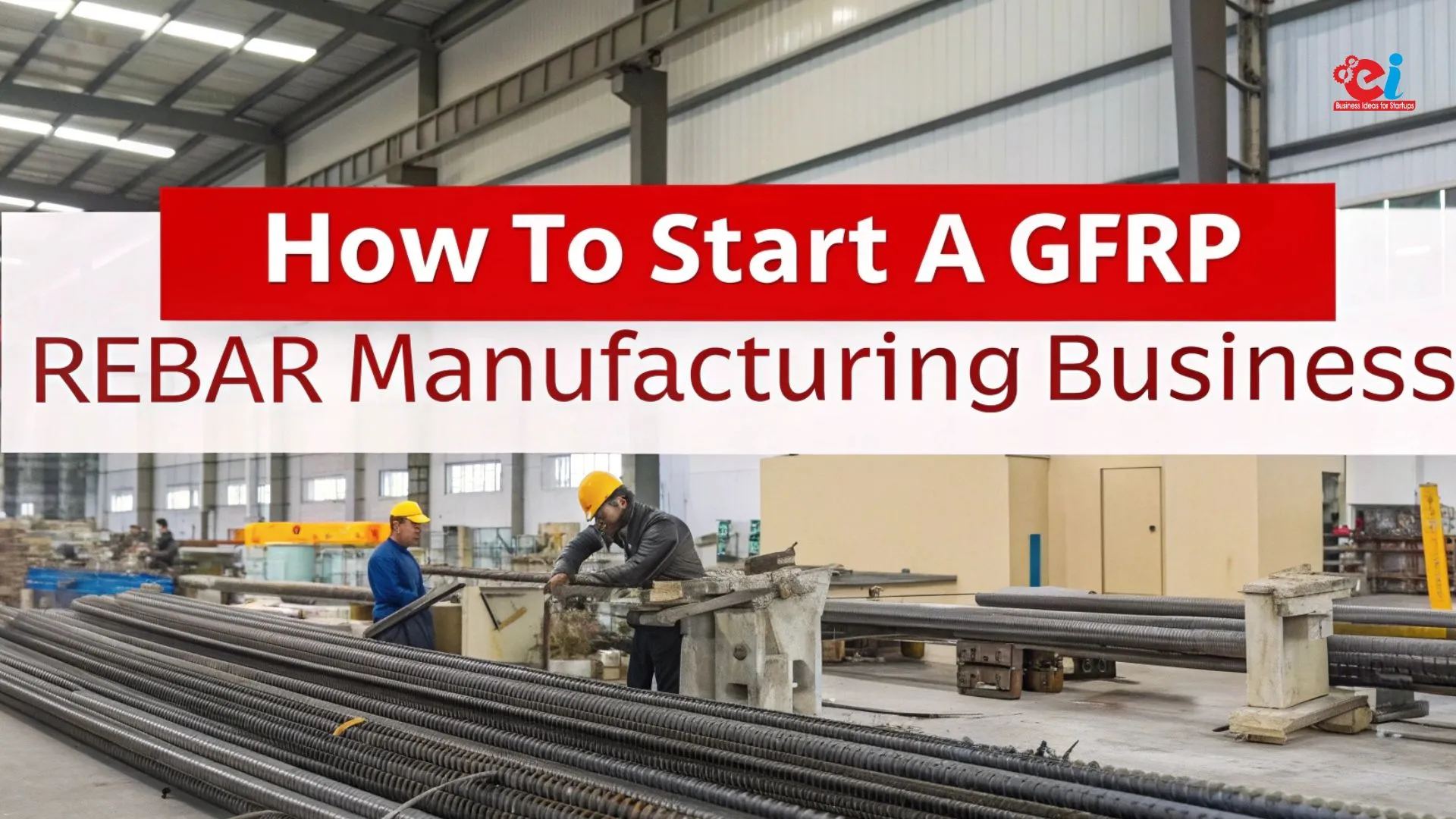An Untapped Opportunity in the Future of Reinforcement
As India modernizes its infrastructure with smart cities, expressways, coastal ports, and metro lines, the construction sector is on the lookout for innovative materials with the required longevity, resilience, strength and sustainability? GFRP Rebar are one of the advancements that are rapidly being adopted.
They are fortified against corrosion, and in comparison to traditional steel rebars, GFRP rebar are lighter and stronger. These characteristics make GFRP rebars perfect for projects susceptible to moisture and chemicals such as bridges, marine structures, underwater tunnels, and water treatment facilities.
The GFRP rebar market in India on the other hand is still in its infancy which means enormous opportunities for first-mover entrepreneurs. This guide provides a? actionable and practical blueprint for industrialists and manufacturers wishing to venture into the GFRP space. From the manufacturing processes and resources needed, technical details, compliance requirements, strategic business growth, and everything else needed to establish a successful, resilient and future-ready manufacturing business, we will discuss it all.
Why GFRP Rebars Are Replacing Steel in Modern Construction
Steel rebars are one of the most useful materials in the construction industry for several years, but like any other material, it has its limitations. For example, steel is prone to corrosion. In high humidity or saline environments, steel can weaken entire structures and maintenance costs. GFRP rebars eliminate this risk.
Manufactured using Continuous glass fibers bound with thermosetting resin like epoxy or vinyl ester, GFRP rebars possess comparable tensile strength to steel while being much lighter. Their non-conducive thermal and electrical properties and lack of rusting makes them suitable for delicate installations like hospitals and defense structures.
In the eyes of the business world, GFRP is not a trend. Investment infrastructure designers and project consultants are consistently incorporating GFRP in tender documents and builders have become more open to strategies that help sustain the life cycle of the assets.
Related: How to Set up Your Production Business of Glass Fiber Reinforced Polymer (GFRP) Rebar
The GFRP Manufacturing Process Explained
Before planning your plant setup, it’s important to understand the manufacturing process. The GFRP rebars are produced using a method called pultrusion, which is a continuous method that ensures uniformity, high production rates, and low wastage, preferable for scalable manufacturing.
The process starts with drawing glass fiber rovings from several spools and threading them through a resin bath. The resin which is usually a mix of epoxy or vinyl ester, augmented with curing agents and other performance additives. It is then heated to solidify into the desired profile.
After this, the rebars are cooled and cut to specified lengths. They undergo a quality assessment and are packaged for shipment. If every step is executed properly, the composite rebars are strong and uniform in strength, finish, and dimensions.
The uninterrupted working model is one of the advantages of the pultrusion method. It streamlines production efficiency and scalability. Automation can be implemented for various phases of the process, such as resin feeding and surface coating, which benefits both MSME and mid-cap manufacturers.
Raw Materials and Setup Requirements
Plant setup along with raw material procurement for starting up a GFRP Rebar unit requires strategic planning.
The primary materials required include:
- Glass Fiber Rovings: These have high-grade rovings which enhances product performance.
- Polymer Resin (Epoxy or Vinyl Ester): For binding matrix, choice is made based on the applications needed.
- Curing Agents and Accelerators: Used during pultrusion phase and added to start the hardening phase of the resin.
- Silica Sand or Wrapping Yarn: Coating materials that increase bonding with concrete structures.
Your essential investments from a plant setup perspective will be:
- Pultrusion Machine with die heating and pulling system
- Resin Mixing Station and storage tanks
- Cutting and Cooling System
- Quality Control Lab with basic mechanical testing equipment
With 10,000–15,000 sq. ft. of industrial land, a plant with the right power and water supply can house the machinery, raw material storage, production, and packaging. There will be a need for skilled workers to operate the machines, manage resin formulations, and oversee production quality.
For more Information Check Our Project Reports
Compliance and Standards: What Indian Manufacturers Need to Know
To manufacture GFRP rebars in India legally and profitably, your product needs to comply with IS 16658:2017, which is the BIS specification for GFRP rebars. This certification is necessary to bid for government projects and gain credibility in the private sector.
Apart from this technical standard, entrepreneurs need to ensure:
- Company registration (under MSME or Private Limited format)
- GST Registration
- Pollution Control Board (PCB) Approval
- Factory license as per state regulations
- Power load sanction for industrial operations
These compliances not only help with business operation but also provide access to government aid and industrial schemes under the “Make in India” and “Startup India” initiatives.
Applications and Buyers: Who Is Likely to Buy GFRP Rebars?
As GFRP rebars are strictly a B2B product, sales and purchases occur within specific industries. Your buyers will mainly be:
- EPC (Engineering, Procurement, Construction) companies executing large-scale public civil works projects.
- Government contractors working on highways, metros, ports, and smart city projects.
- Builders of industrial facilities like refineries, water plants, and power plants.
- Manufacturers of precast concrete components.
Additionally, GFRP has some specific applications in the defense, aerospace, and marine fields where electromagnetic neutrality and corrosion resistance is vital.
Related: Glass Fiber Reinforced Polymer (GFRP) Rebar Manufacturing Plant
Marketing and Sales Strategy: Accessing B2B Customers
Focusing on large organizations as your customers means that your sales strategy has to combine both technical aspects and relationship building. Start with a clean, professional website that allows for datasheet downloads showcasing applications, testing results, and industry certifications. This is your digital business card.
Market your company on IndiaMART, TradeIndia, and the GeM portal so that you can be found by government departments and contractors. At the same time, proactively build relationships with structural engineers, civil consultants, and project designers as these people have significant influence and buy decisions during the tendering stage.
Offering free samples, test results, and help with designing integration into existing systems goes a long way to build trust. For large infra development companies, strive to gain approved vendor status to improve long-term relationships.
Anticipated Challenges & What Business Owners Should Be Prepared For
Incorporating a material such as GFRP translates to an industry-wide shift from decades of steel dependency. With GFRP’s advantages, buyer readiness is a hurdle.
You can address this challenge through education by offering technical workshops or publishing performance and lifecycle cost comparisons. Another hurdle is product consistency greatly impacted by improper resin-fiber ratios or curing within the industry’s quality control framework. This risk is mitigated by investing in skilled quality assurance teams and automated systems.
Lastly, while competition is scarce, it is on the rise. As this segment of the market is new to the country, the first few entrants will be able to set the pace in establishing brand loyalty and securing long-term partnerships.
What Helps NPCS to Start Your GFRP Rebar Business
Every industrial undertaking requires thorough planning, conducting market analysis, designing the process, and regulatory compliance. This is where Niir Project Consultancy Services (NPCS) comes in.
NPCS creates the Market Survey cum Techno-Economic Feasibility Reports for validating and executing business ideas. Some of the specific points covered in the reports include:
- The manufacturing process of the plant and the flow of materials through it
- The layout of the plant and the selection of machines
- The sourcing strategies for the raw materials needed
- Applicable laws and requirements, including compliance and governmental policies
- Trends and forecasts in the market
- Estimated finances, including detailed projections and break-even analysis
For current manufacturers looking to expand into GFRP as well as for new entrepreneurs entering the field, NPCS makes sure that the ideas can be transformed into detailed plans strategically designed for success.
Conclusion: A Smart Industrial Business for the Next Decade
India’s infrastructure transformation is well underway, and it demands materials that last longer, perform better, and cost less in the long run. GFRP rebars, with their corrosion-free and high-strength properties, are no longer an experimental product—they are becoming a mainstream alternative.
By entering this market now, you’re not only capitalizing on a gap in the industrial supply chain but also contributing to building smarter, stronger public assets. With the right planning, compliance, and guidance, your GFRP rebar manufacturing business can be the foundation for long-term success in the growing Indian manufacturing economy.






